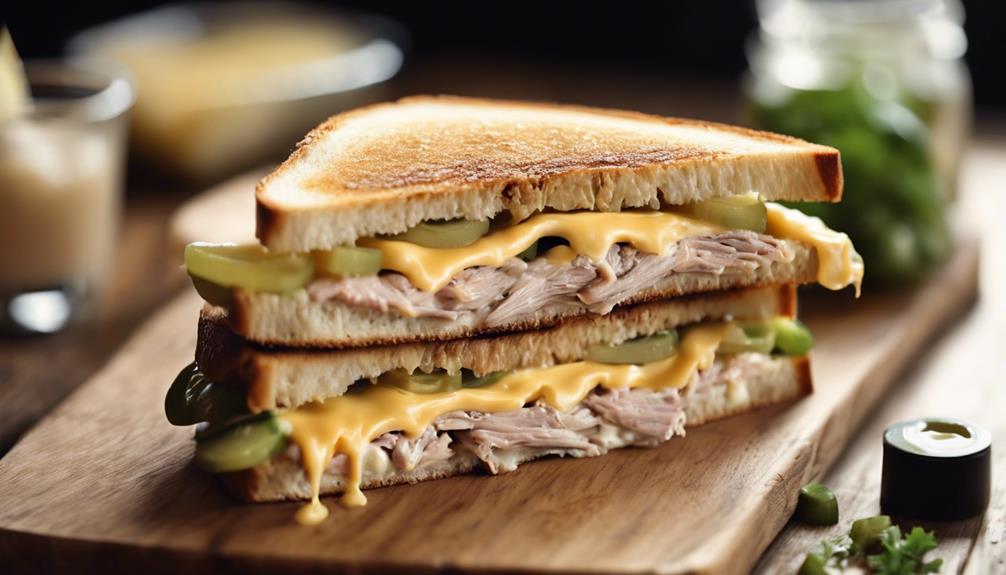Comfort eating is a way you might use food to cope with tough emotions, like stress or sadness. When you feel overwhelmed, reaching for high-calorie comfort foods provides momentary relief. This behavior, however, can create a cycle of guilt and shame, making your feelings worse over time. Your emotional triggers often stem from past experiences or current stressors. It's important to recognize these triggers so you can find healthier coping strategies. If you find yourself struggling, there are effective methods to help. Discovering these strategies can lead to more balanced emotional health and well-being.
Key Takeaways
- Comfort eating, or emotional eating, is a coping mechanism for dealing with negative emotions and stress through food.
- Psychological triggers, like childhood experiences and low self-esteem, significantly influence patterns of emotional eating.
- Hormonal fluctuations, particularly cortisol, can increase cravings for high-fat and high-sugar comfort foods.
- Emotional eating often leads to guilt and shame, perpetuating a harmful cycle of negative emotions and poor health outcomes.
- Developing healthier coping strategies, such as mindfulness and physical activity, can help break the cycle of comfort eating.
Definition of Comfort Eating

Comfort eating, or emotional eating, occurs when you turn to food to cope with negative emotions like stress, sadness, or anxiety instead of addressing physical hunger. This behavior often leads you to high-calorie comfort foods, such as sweets and junk food, which provide temporary relief but can quickly spiral into unhealthy eating patterns.
You might find yourself reaching for these foods during stressful times, as studies indicate that about 40% of people use food as a coping mechanism. For many, indulging in dishes like Mushroom Masala or sweet treats like Rasgulla can evoke feelings of nostalgia and comfort, making them popular choices during emotional distress.
However, this approach can create a cycle of overeating followed by guilt and shame, amplifying your negative emotions instead of alleviating them. Over time, comfort eating can contribute to serious health issues, including obesity and related diseases.
By relying on food for emotional comfort, you risk developing an emotional dependency that makes it harder to break free from unhealthy habits.
Recognizing comfort eating as a response to your feelings is vital. It's not just about satisfying hunger; it's about addressing underlying issues. Understanding this definition can help you start to explore healthier coping mechanisms and make more conscious choices about how you manage your emotions.
Psychological Triggers

When you face stress or negative emotions, you might turn to food as a way to cope, often without realizing it.
Comfort foods like satisfaction from fried pork chops can evoke nostalgia and provide a sense of security.
Your childhood experiences can shape these patterns, making emotional eating feel like a familiar response.
Understanding these psychological triggers can help you develop healthier emotional regulation strategies.
Emotional Regulation Strategies
Many people turn to food as a way to cope with their emotions, often relying on it during stressful or sad moments. This reliance on comfort food can stem from difficulties in emotional regulation.
Emotional eaters frequently struggle with cognitive reappraisal, which makes it harder to evaluate situations differently and can lead to unhealthy eating behaviors. When negative feelings arise, you might find yourself reaching for snacks instead of addressing the root of your stress or sadness.
Preparing nutritious dishes like Nettle and Potato Soup can be a healthier alternative that nurtures both body and mind.
To break this cycle, it's crucial to develop alternative strategies. Mindfulness practices can help you become more aware of your emotions, allowing you to manage stress without turning to food. By tuning into your feelings, you can better understand what triggers your emotional eating.
Engaging in physical activities also provides an effective outlet for emotions, channeling stress into something positive.
Stress and Coping Mechanisms
Stress often triggers a range of emotional responses, and for some, food becomes a go-to coping mechanism. When you face high levels of stress, it's common to seek comfort food, as studies show that emotional eating often fills that need.
Increased cortisol levels can lead to cravings for high-fat and high-sugar foods, reinforcing unhealthy eating patterns. It's easier to reach for that slice of cake than to confront underlying emotional issues. Comfort foods like Red-Braised Pork Belly can provide a sense of nostalgia and warmth, making them particularly appealing during stressful times. This cycle of stress-induced eating not only impacts physical health but can also deepen emotional struggles, creating a challenging loop to break. Interestingly, colors that influence eating habits also play a subtle role in food choices during these moments. For example, warm, inviting hues like red and yellow are known to stimulate appetite, further encouraging indulgence in comfort foods.
Psychological factors play a significant role in this behavior. If you struggle with emotional regulation, you might find yourself turning to food to cope with stress instead of developing healthier strategies. This can create a habitual response, where food becomes your primary source of comfort, making it tough to break the cycle.
After indulging, many emotional eaters report feelings of guilt and shame, which only intensifies the stress and leads to further emotional eating.
To combat this, it's essential to recognize these patterns and explore alternative coping mechanisms that don't involve food. By doing so, you can foster healthier ways to manage stress and reduce reliance on comfort food as a solution.
Influence of Childhood Experiences
Childhood experiences shape your relationship with food in profound ways. From a young age, you may have learned to associate food with comfort, especially if your parents rewarded good behavior with treats. This pattern can lay the groundwork for emotional eating, where food becomes a go-to coping mechanism during stressful times.
If high-calorie comfort foods were your go-to during emotional distress, it's likely that you still gravitate toward these foods in similar situations as an adult. For instance, many people find solace in familiar flavors, such as the comforting taste of traditional Brazilian desserts that evoke memories of family gatherings or celebrations.
Moreover, if you experienced low self-esteem or emotional neglect, turning to food for solace might've felt like a natural response. This behavior often becomes ingrained, creating a cycle of reliance on food to manage your feelings.
Additionally, you probably picked up on your parents' eating behaviors, mimicking their coping strategies. If they used food to handle stress, you're likely to do the same.
Recognizing how these childhood experiences influence your current eating habits can be the first step toward healthier behaviors. Understanding these patterns enables you to seek alternative coping mechanisms that promote emotional well-being without relying solely on food for comfort.
Biological Factors

Biological factors play an essential role in shaping emotional eating behaviors, greatly impacting how individuals respond to their feelings. Hormonal changes, particularly fluctuations in cortisol during stressful times, can heighten emotional sensitivity and appetite, leading to stress eating.
For instance, many people might reach for comfort foods like Dorayaki (Red Bean Pancake) during tough moments, as they provide a sense of nostalgia and warmth. If you find yourself eating more during tough moments, it's partly due to these biological influences.
Research shows that overweight individuals tend to engage more in emotional eating, often overeating in response to negative emotions compared to those at a normal weight. Additionally, women are generally more affected due to hormonal influences related to their menstrual cycles, which can alter mood and appetite.
The gut-brain axis also highlights the connection between your digestive health and mood. Gastrointestinal hormones and gut microbiota can notably impact your emotional well-being and eating behaviors.
Neurotransmitters like dopamine further complicate this relationship, as they play an essential role in the pleasure response associated with eating. This is why high-fat and high-sugar foods can feel especially appealing when you're experiencing emotional distress.
Understanding these biological factors can help you navigate your emotional eating patterns more effectively.
Emotional Consequences

How does emotional eating impact your overall well-being? When you turn to comfort foods to manage negative emotions, you might find yourself caught in a cycle of emotional eating. This behavior can lead to feelings of guilt and shame after indulging, further amplifying your distress. As you rely on food to satisfy emotional hunger, you could develop body image issues, especially if this pattern results in weight gain.
Comfort foods, often rich and flavorful like traditional dishes such as Muamba De Galinha or sweet treats like Mandazi, can provide temporary solace but may not address underlying emotional needs.
Moreover, emotional eating often doesn't just mask your feelings; it can exacerbate them. Research shows that those who frequently engage in this behavior may experience heightened anxiety and depression, as the root issues behind your emotions remain unaddressed. This reliance on food as a coping mechanism can create maladaptive patterns that complicate your mental health.
Over time, you might find yourself at risk of developing disordered eating behaviors, making it even harder to break free from this cycle. Instead of turning to comfort foods, recognizing and addressing your feelings could be key to improving your emotional well-being and overall health.
Understanding these emotional consequences is essential to reclaiming control over your relationship with food and your feelings.
Coping Strategies

To manage emotional distress without turning to comfort eating, you can explore mindful eating techniques and alternative coping mechanisms.
By slowing down during meals and focusing on each bite, you'll become more aware of your hunger cues. Incorporating meals like pasta with tomato sauce can bring a sense of warmth and nostalgia, enhancing your overall dining experience.
Additionally, engaging in physical activities or mindfulness practices can provide healthier outlets for your emotions.
Mindful Eating Techniques
Mindful eating techniques offer powerful coping strategies for those grappling with comfort eating habits. By slowing down and savoring each bite, you can enhance your enjoyment of food and become more attuned to your hunger cues. Engaging your senses—focusing on textures, flavors, and aromas—deepens your eating experience, helping you appreciate food in a new light.
For instance, enjoying a traditional dessert like Kue Putu can elevate your mindfulness as you relish the warm, rich flavors of rice flour and palm sugar.
Taking intentional pauses between bites allows you to reflect on emotional triggers that may lead to emotional eating. This practice helps you differentiate between true hunger and emotional cravings, promoting healthier eating choices.
Additionally, incorporating mindfulness techniques, like deep breathing or meditation before meals, can address emotional discomfort without resorting to comfort food.
Keeping a food diary that captures your feelings and thoughts during meals can greatly boost your self-awareness around your eating patterns. By tracking your emotions alongside your food choices, you can identify situations that trigger emotional eating, paving the way for better decisions in the future.
Ultimately, practicing mindful eating not only supports healthier habits but also nurtures a more positive relationship with food.
Alternative Coping Mechanisms
Finding healthier ways to cope with emotional challenges can considerably reduce the urge to turn to food for comfort. Instead of resorting to emotional eating, consider alternative coping mechanisms that promote well-being. Engaging in physical activities, like walking or yoga, can effectively reduce stress and elevate your mood. These activities serve as healthier outlets, steering you away from cravings.
For example, preparing Turkey Soup with leftover turkey can be a comforting way to engage in a productive task while enjoying the warm flavors of the season.
Hobbies and creative pursuits, such as painting or writing, offer emotional fulfillment and distraction from the urge to eat. They help you break the cycle of seeking comfort in food. Additionally, practicing mindfulness techniques, like meditation or deep breathing exercises, enhances your awareness of emotions and improves emotional regulation, making it easier to manage cravings.
Building a supportive social network is also crucial. Connecting with friends or family provides emotional support and reduces feelings of loneliness, which can otherwise lead to comfort eating.
When to Seek Help

Recognizing the signs that it's time to seek help is fundamental for anyone struggling with comfort eating. If you find yourself frequently losing control over your eating habits, feeling unable to stop despite wanting to, it's important to pay attention to these feelings that triggered your behavior.
Eating to the point of discomfort and experiencing shame or guilt about your eating patterns are significant warning signs that suggest you might need support.
Additionally, if you're engaging in harmful behaviors like self-induced vomiting, it's imperative to consult a health care provider immediately. These actions can indicate serious underlying issues that require professional intervention. Early intervention for emotional eating can make a considerable difference, helping you avoid the development of more severe eating disorders.
Consider reaching out to mental health professionals who specialize in eating behaviors. They can provide essential guidance and coping strategies tailored to your unique challenges.
Long-term Solutions

Sustainable change in comfort eating habits often stems from cultivating healthier coping mechanisms. Instead of turning to food during emotional highs and lows, you can develop alternative coping strategies. Engaging in hobbies, practicing mindfulness, and tracking emotional triggers through an emotion diary can help you recognize patterns and foster mindful eating.
Incorporating regular physical activity into your routine not only boosts your mood but also regulates your appetite, making it easier to manage emotional eating. This connection can facilitate long-term weight loss while reducing the frequency of emotional eating episodes.
Gradual dietary changes are also vital. By prioritizing whole foods and balanced meals, you can diminish the cycle of emotional eating over time.
Building a supportive social network is equally important; having people around you can provide accountability and emotional support, which are essential in overcoming these habits.
Frequently Asked Questions
What Is the Science Behind Comfort Eating?
Comfort eating involves complex brain mechanisms, where your body releases dopamine, creating a sense of pleasure. This response can lead you to seek out high-calorie foods as a way to cope with emotional distress.
What Is the Psychology Behind Comfort Food?
When life feels like a storm, you might turn to comfort food for shelter. It's your brain's way of seeking solace, triggering memories of warmth and safety, while soothing your emotional turbulence with every bite.
What Is the Psychology Behind Eating for Pleasure?
When you eat for pleasure, you're seeking enjoyment and satisfaction. This often stems from positive associations with food, rewarding experiences, or simply the desire to indulge, creating a momentary escape from reality and stress.
What Is the Medical Term for Comfort Eating?
You might not realize it, but comfort eating has a medical term—emotional eating. It involves consuming food to cope with feelings rather than hunger, often leading to complex health challenges you may not expect.
Conclusion
In the journey of understanding comfort eating, you might find that it mirrors your own experiences—those late-night snacks after a tough day or indulging in a favorite dish during celebrations. Recognizing the psychological triggers and emotional consequences is essential. By exploring coping strategies and knowing when to seek help, you can rewrite your relationship with food. Remember, it's not just about what you eat; it's about how you feel—and that connection could spark a transformative change in your life.










